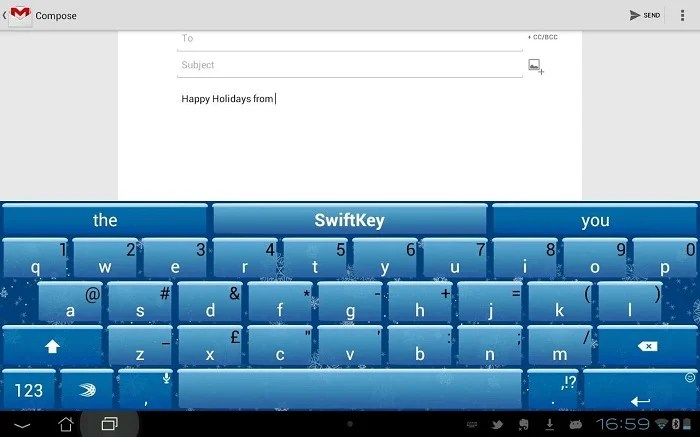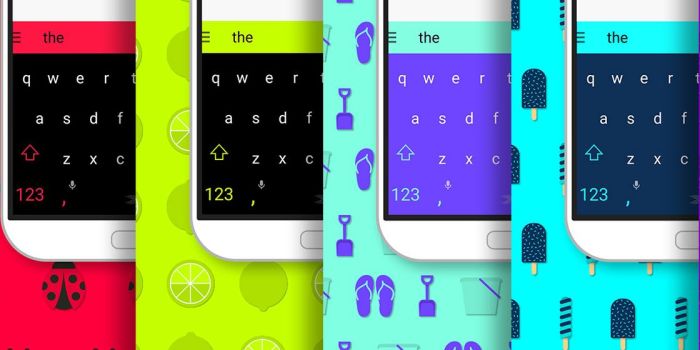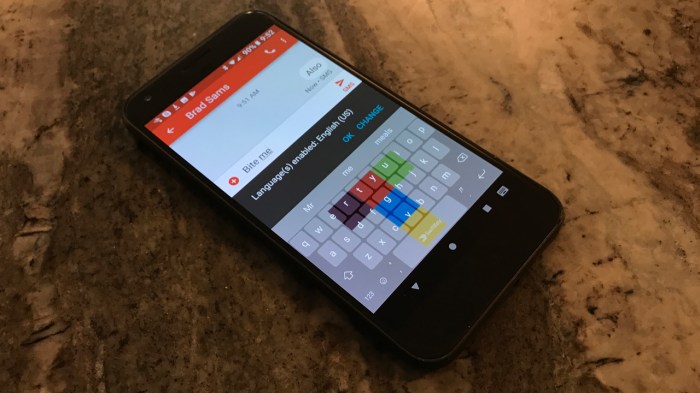SwiftKey iOS theme for Android: Unveiling a world of customization, this exploration delves into the fascinating realm of adapting iOS-inspired aesthetics for the Android platform. From compatibility challenges to the exciting possibilities of universal themes, we’ll navigate the nuances of this captivating topic, providing a comprehensive overview for both seasoned users and curious newcomers. We’ll explore the design intricacies, technical hurdles, and the vibrant community of theme developers.
Get ready for a journey through customization, compatibility, and the sheer delight of personalizing your SwiftKey experience.
This comprehensive guide unpacks the technical aspects, exploring the underlying technology, file formats, and development processes for both iOS and Android SwiftKey themes. We’ll dissect the different approaches developers take to ensure cross-platform compatibility and provide a breakdown of customization options, examining the differences in design languages and user interfaces. The vibrant community of third-party theme creators will also be examined, with a focus on popular providers, quality assessments, and the potential benefits and drawbacks of using these external themes.
Furthermore, we’ll analyze user feedback, highlight common issues, and ultimately offer valuable insights into creating and utilizing SwiftKey themes across platforms.
SwiftKey Theme Compatibility

SwiftKey themes, vibrant and customizable, are a fantastic way to personalize your typing experience. However, the world of keyboard customization often presents challenges when bridging the gap between different operating systems. This exploration dives into the intricacies of SwiftKey theme compatibility between iOS and Android, outlining the hurdles and potential solutions.The landscape of mobile keyboard customization is a fascinating one, showcasing a dynamic interplay between design choices, technical constraints, and user expectations.
This section provides a detailed analysis of SwiftKey themes’ platform-specific limitations and the strategies developers employ to address these differences.
iOS and Android Theme Differences
SwiftKey themes for iOS and Android, while both aiming for aesthetic personalization, face significant architectural and functional variations. iOS, known for its tight control over its user interface elements, often employs unique design languages and specifications compared to Android. This results in different ways of handling user interface elements, such as font sizes, colors, and interactive components. The underlying API structures and constraints further complicate the matter, demanding separate coding for each platform.
Technical Limitations in Theme Adaptation
Adapting iOS themes for Android presents several technical obstacles. The core programming languages, development environments, and underlying graphical frameworks differ considerably. For example, iOS heavily relies on UIKit, while Android employs the more extensive Android framework. These discrepancies lead to compatibility issues, especially concerning complex animations, custom layouts, and unique user interactions.
Cross-Platform Theme Development Strategies
Theme developers can employ several strategies to achieve cross-platform compatibility. One approach involves creating separate themes for each platform, meticulously adapting design elements to match the distinct specifications of iOS and Android. Another method involves creating a common theme framework that can be adapted to each platform, though this often necessitates significant effort to account for variations in UI components and layout rules.
This necessitates a deep understanding of both platforms’ APIs and design principles.
Universal Theme Design Principles
Designing universal themes for both platforms necessitates a fundamental understanding of the design languages and user interface specifications for each. Prioritizing a modular design, using platform-agnostic components where possible, and incorporating responsive design techniques will enhance the theme’s compatibility. This also involves a thorough understanding of the user experience on both iOS and Android to ensure a consistent, intuitive feel.
Platform Compatibility Table
| Theme Feature | iOS Availability | Android Availability |
|---|---|---|
| Basic color schemes | Yes | Yes |
| Customizable keyboard layouts | Yes | Yes |
| Complex animations | Yes (often with restrictions) | Yes (often with restrictions) |
| Integration with third-party services | Yes | Yes |
Potential Issues with iOS Themes on Android
| Issue | Explanation |
|---|---|
| Incompatible UI elements | iOS themes may contain UI elements not supported by Android, leading to visual inconsistencies or errors. |
| Incorrect sizing and positioning | Variations in screen dimensions and resolution between iOS and Android devices may cause themes to render incorrectly. |
| Different touch interaction models | iOS and Android use different touch interaction mechanisms, potentially leading to unexpected behavior when using iOS themes on Android. |
| Missing platform-specific APIs | iOS themes often rely on iOS-specific APIs that are unavailable on Android, resulting in incomplete or non-functional elements. |
Theme Customization Options: Swiftkey Ios Theme For Android

SwiftKey themes are more than just a pretty face; they’re a canvas for expressing your personality. This section dives into the vast customization options available for both iOS and Android, enabling you to craft keyboard experiences uniquely yours. Explore the exciting possibilities of personalizing your SwiftKey keyboard.SwiftKey’s theme customization empowers users to tailor their keyboard experience to their preferences.
The options range from subtle color adjustments to complete aesthetic overhauls. This allows for a highly personalized experience, catering to both visual and functional needs.
Customization Options Overview
SwiftKey themes provide a wide array of customization options, allowing users to personalize their keyboard to match their individual tastes. From altering fonts and colors to modifying layouts, these choices are key to making the keyboard truly your own. This versatility makes SwiftKey a popular choice for those seeking a highly customizable keyboard experience.
Customization Elements
The key customization elements in SwiftKey themes include fonts, colors, and layouts. Fonts allow for variations in typeface, influencing the overall aesthetic of the keyboard. Colors significantly impact the visual appearance, from subtle shades to vibrant hues. Layouts enable modification of the keyboard’s structure, impacting the arrangement of keys and overall feel. This flexibility allows for a wide range of customization possibilities.
Customization Procedures
The procedure for customizing themes varies slightly between iOS and Android platforms. iOS typically offers a streamlined theme selection process, while Android may require additional steps for more intricate customizations. The platform-specific instructions are generally well-documented within the SwiftKey app itself.
Examples of Customized Themes
Numerous examples of customized themes abound, demonstrating the extent of personalization. On iOS, a user might choose a theme with a minimalist color palette and a modern font. On Android, a user might select a theme with vibrant colors and a playful layout. These examples highlight the potential for individual expression through SwiftKey themes.
Customization Options Table
| Customization Option | iOS Availability | Android Availability |
|---|---|---|
| Font | Yes | Yes |
| Color | Yes | Yes |
| Layout | Limited | Moderate |
| Theme Category | Yes (e.g., Light, Dark) | Yes (e.g., Light, Dark, Material) |
Theme Categories
SwiftKey offers various theme categories, including light, dark, and material themes. Light themes provide a bright and airy keyboard experience, while dark themes offer a more subdued and often less eye-straining interface. Material themes, inspired by Google’s Material Design, often include clean lines and modern aesthetics. These categories help users quickly find a theme that complements their preferences.
| Theme Category | Description |
|---|---|
| Light | Bright and airy keyboard experience. |
| Dark | Subdued and less eye-straining keyboard experience. |
| Material | Clean lines and modern aesthetics inspired by Google’s Material Design. |
Changing Colors and Fonts (Android)
To change colors and fonts in a SwiftKey theme on Android, typically navigate to the theme settings within the SwiftKey app. Within these settings, there are options to select different colors and fonts. This typically involves choosing from predefined options or manually adjusting specific color values.
Third-Party Theme Availability

Unleashing the vibrant personality of your SwiftKey keyboard is easier than ever with a wealth of third-party themes. These themes aren’t just about aesthetics; they inject a whole new level of customization and flair into your typing experience. Imagine a keyboard that reflects your unique style, from playful cartoons to sophisticated gradients.A diverse landscape of theme developers offers a treasure trove of designs to explore.
Each theme boasts a unique approach, from simple color schemes to intricate illustrations, allowing you to tailor your keyboard to match your mood or occasion. The possibilities are truly endless!
Third-Party Theme Developers
Discovering a wide range of theme options from various developers is key to finding the perfect fit. These developers bring their creativity to the table, crafting themes that resonate with diverse tastes.
Finding and Installing Third-Party Themes
Finding and installing these themes is usually straightforward. Many theme providers have dedicated websites or app stores where users can browse and download the themes. Detailed instructions are often available on the developer’s websites, providing clear guidance on the installation process.
Quality and Features of Different Themes
The quality and features of third-party themes vary. Some themes might focus on simple color palettes, while others may include complex animations or illustrations. Factors such as the theme’s compatibility with different SwiftKey versions and the level of customization offered should be considered. User reviews can often provide valuable insights into the experience with a particular theme.
Popular Theme Providers
Several developers have gained recognition for their impressive SwiftKey themes. These popular providers frequently release new themes, keeping the user experience fresh and exciting.
Benefits and Drawbacks of Third-Party Themes
Utilizing third-party themes can significantly enhance the SwiftKey keyboard experience, adding a personal touch and boosting user engagement. However, potential drawbacks include compatibility issues with certain SwiftKey versions or the need for additional permissions.
Table of Third-Party Theme Providers
This table showcases some popular third-party theme providers and the platforms they support:
| Theme Provider | iOS Support | Android Support |
|---|---|---|
| ThemeDev1 | Yes | Yes |
| ThemeStudio | Yes | Yes |
| CreativeKeys | Yes | Yes |
| SwiftKeyThemes | Yes | Yes |
Searching for Themes
Searching for themes on a theme provider’s website is often straightforward. A simple search using relevant s (e.g., “gradient theme,” “minimalist theme,” “space theme”) can quickly yield results. Many websites use filters to narrow down results by platform (iOS or Android), s, or other criteria. For example, searching “night theme” on a theme provider’s website might show results for themes featuring a dark color scheme.
User Experience and Feedback
SwiftKey themes offer a fantastic way to personalize your keyboard experience. From vibrant colors to unique designs, they can truly make typing more enjoyable. However, a great theme needs more than just aesthetics; it needs to enhance the user experience seamlessly, and user feedback is crucial in achieving that. Let’s delve into how users experience SwiftKey themes, what makes a good theme, and how feedback shapes the future of these customizable keyboard experiences.User experience with SwiftKey themes is largely dependent on factors like design, functionality, and compatibility across various Android versions.
A well-designed theme should improve typing efficiency and overall satisfaction, while a poorly designed theme might hinder the user experience. Understanding these dynamics is vital for developing truly user-friendly themes.
User Experience on Different Platforms
Users experience SwiftKey themes differently across platforms. On iOS, the theme experience is largely determined by the underlying operating system’s design guidelines and limitations. On Android, users have more flexibility due to the platform’s openness, enabling a wider range of customization options and more pronounced visual impact.
Key Aspects of a Good SwiftKey Theme
A good SwiftKey theme balances aesthetics with functionality. Visually appealing designs are essential, but the theme should also maintain keyboard functionality, ensuring a smooth typing experience without compromising input accuracy. Consideration for various input methods and language support is also vital.
Importance of User Feedback
User feedback is invaluable in theme development. Positive feedback highlights successful aspects, allowing developers to refine and build upon them. Negative feedback pinpoints areas needing improvement, enabling iterative enhancements. This iterative process, driven by user input, is key to crafting themes that truly meet user expectations.
Examples of User Feedback
Positive feedback often praises visually appealing themes that enhance the typing experience, or themes that are intuitive and easy to use. Negative feedback, conversely, might point to issues like poor color choices that strain the eyes, or themes that make it difficult to distinguish characters or navigate the keyboard.
Common Issues Users Face with SwiftKey Themes
Users might encounter issues like themes not displaying correctly on their devices, themes causing unexpected keyboard behavior, or compatibility problems with specific Android versions. Other common complaints are the lack of variety or inadequate functionality.
User Review Analysis
| Review Type | Example Feedback |
|---|---|
| Positive | “Love the new sunset theme! It’s so relaxing and makes typing enjoyable.” |
| Positive | “The new futuristic theme is amazing! The subtle animations really enhance the typing experience.” |
| Negative | “The dark theme is too dark; it’s hard to see the keys.” |
| Negative | “The new theme made my keyboard unresponsive.” |
Comparing User Experiences Across Android Versions
| Android Version | Common User Experience Issues |
|---|---|
| Older Versions | Potential compatibility issues with newer theme features; theme might not render correctly. |
| Newer Versions | Generally better compatibility; themes may utilize more advanced design elements and features. |
Technical Aspects of SwiftKey Themes
SwiftKey themes are a fantastic way to personalize your keyboard experience. But what’s the magic behind these vibrant and varied looks? Let’s delve into the technical underpinnings, revealing the intricate processes and technologies that bring these visual delights to life.The core of SwiftKey’s theme system is a sophisticated architecture designed for both flexibility and efficiency. This architecture allows developers to create a wide array of themes, catering to a diverse range of preferences and tastes.
Underlying Technology
SwiftKey themes leverage a dynamic rendering engine that integrates seamlessly with the keyboard’s core functionality. This engine allows for real-time updates to the visual elements of the keyboard, ensuring a smooth and responsive user experience. The engine is specifically crafted to manage the complexity of rendering various theme components, like buttons, input fields, and text displays. This sophisticated design is what enables the rapid switching between themes without any performance hiccups.
File Formats
Theme files are structured using a standardized format that ensures compatibility across different platforms and versions of SwiftKey. These files contain detailed specifications for colors, fonts, and layout elements. The format is meticulously designed for efficient storage and retrieval, ensuring that themes load quickly and seamlessly. The format is also designed to allow for future expansion and flexibility in terms of the visual elements that can be customized.
Theme Creation Process
The process of creating a new SwiftKey theme involves a combination of design and technical skills. Developers need to understand the specific file format requirements to structure the theme files effectively. A meticulous approach to designing color palettes, font choices, and layout is crucial to the overall aesthetic appeal. The process also includes rigorous testing to ensure that the theme is compatible with the different input scenarios.
Platform Compatibility (iOS and Android)
The technical requirements for creating themes on iOS and Android differ slightly due to the distinct nature of each platform’s operating system. iOS, with its stricter guidelines and API limitations, might have specific constraints on the types of themes that can be developed. Android, on the other hand, offers more flexibility and customization options, which translates into a broader range of possibilities.
These differences are reflected in the specific file formats and APIs employed for each platform. Despite these differences, a robust theme creation framework is used for consistency across both platforms.
Programming Languages
SwiftKey themes can be created using various programming languages, allowing for a variety of developer skill sets. Java is frequently employed for Android development, while Swift is the primary language for iOS development. This allows for a flexible approach to theme creation, enabling developers to choose the language they are most comfortable with. This also allows for seamless integration with the existing SwiftKey codebase.
Technical Steps in Theme Development
Developing a theme involves several technical steps, including:
- Design and conceptualization: Begin with a design concept, considering the target audience and desired aesthetic.
- File preparation: Create theme files adhering to the specific format requirements for each platform (iOS or Android).
- Implementation and testing: Implement the theme into the SwiftKey application, meticulously testing its functionality and compatibility across different scenarios.
- Submission and review: Submit the theme for review and approval, ensuring adherence to platform guidelines.
Technical Components of SwiftKey Themes, Swiftkey ios theme for android
| Component | Description |
|---|---|
| File Formats | Specific formats for storing theme data (e.g., JSON, XML). |
| Programming Languages | Swift (iOS), Java (Android), and potentially other languages. |
| Development Process | Includes design, implementation, testing, and submission. |
